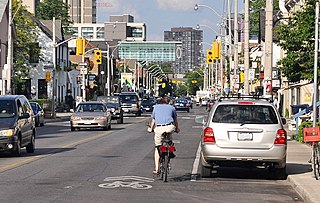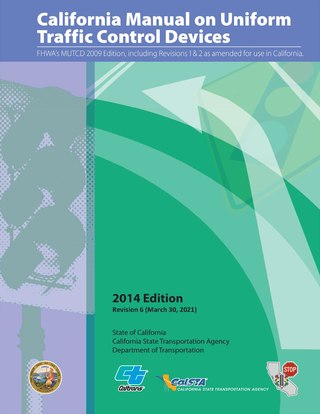Related Research Articles

An intelligent transportation system (ITS) is an advanced application that aims to provide innovative services relating to different modes of transport and traffic management and enable users to be better informed and make safer, more coordinated, and 'smarter' use of transport networks.

Traffic signs or road signs are signs erected at the side of or above roads to give instructions or provide information to road users. The earliest signs were simple wooden or stone milestones. Later, signs with directional arms were introduced, for example the fingerposts in the United Kingdom and their wooden counterparts in Saxony.

A variable-message sign or message board, often abbreviated VMS, VMB, CMS, or DMS, and in the UK known as a matrix sign, is an electronic traffic sign often used on roadways to give travelers information about special events. Such signs warn of traffic congestion, accidents, incidents such as terrorist attacks, AMBER/Silver/Blue Alerts, roadwork zones, or speed limits on a specific highway segment. In urban areas, VMS are used within parking guidance and information systems to guide drivers to available car parking spaces. They may also ask vehicles to take alternative routes, limit travel speed, warn of duration and location of the incidents, inform of the traffic conditions, or display general public safety messages.

Roadworks, also called road construction or road work, occur when part of the road, or in rare cases, the entire road, has to be occupied for work relating to the road, most often in the case of road surface repairs. In the United States road work could also mean any work conducted in close proximity of travel way (thoroughfare) such as utility work or work on power lines. The general term of road work is known as work zone.

The Manual on Uniform Traffic Control Devices for Streets and Highways is a document issued by the Federal Highway Administration (FHWA) of the United States Department of Transportation (USDOT) to specify the standards by which traffic signs, road surface markings, and signals are designed, installed, and used. In the United States, all traffic control devices must legally conform to these standards. The manual is used by state and local agencies as well as private construction firms to ensure that the traffic control devices they use conform to the national standard. While some state agencies have developed their own sets of standards, including their own MUTCDs, these must substantially conform to the federal MUTCD.

A logbook is a record used to record states, events, or conditions applicable to complex machines or the personnel who operate them. Logbooks are commonly associated with the operation of aircraft, nuclear plants, particle accelerators, and ships.
The Research and Innovative Technology Administration (RITA) is a unit of the United States Department of Transportation (USDOT). It was created in 2005 to advance transportation science, technology, and analysis, as well as improve the coordination of transportation research within the department and throughout the transportation community.

The Maryland State Highway Administration is the state mode responsible for maintaining Maryland's numbered highways outside Baltimore. Formed originally under authority of the General Assembly of Maryland in 1908 as the State Roads Commission (SRC), under the direction of the executive branch of state government headed by the governor of Maryland, it is tasked with maintaining non-tolled/free bridges throughout the state, removing snow from the state's major thoroughfares, administering the state's "adopt-a-highway" program, and both developing and maintaining the state's freeway/expressway system. There was a reorganization of the several commissions, bureaus, boards, and assorted minor agencies with departments of the executive branch and establishment of the governor's cabinet in the early 1970s following the adoption of several individual reorganization recommendations after the rejection by the voters in a November 1968 referendum of the 1968 proposed overall new state constitution prepared by the 1967–1968 Constitutional Convention. SHA is now a division of the larger establishment of the Maryland Department of Transportation and is currently overseen by an administrator.

Road traffic control involves directing vehicular and pedestrian traffic around a construction zone, accident or other road disruption, thus ensuring the safety of emergency response teams, construction workers and the general public.
The Illinois Department of Transportation (IDOT) is a state agency in charge of state-maintained public roadways of the U.S. state of Illinois. In addition, IDOT provides funding for rail, public transit and airport projects and administers fuel tax and federal funding to local jurisdictions in the state. The Secretary of Transportation reports to the Governor of Illinois. IDOT is headquartered in unincorporated Sangamon County, located near the state capital, Springfield. In addition, the IDOT Division of Highways has offices in nine locations throughout the state.

A shared lane marking, shared-lane marking, or sharrow is a street marking installed at various locations worldwide, such as New Zealand, Australia, Canada, Spain, and the United States. This marking is placed in the travel lane to indicate where people should preferably cycle.

A radar speed sign or speed feedback sign is an interactive sign comprising a speed-measuring device and a message sign generally constructed of a series of LEDs, which displays vehicle speed of approaching motorists. The purpose of radar speed signs is to slow cars down by making drivers aware when they are driving at speeds above the posted limits. They are used as a traffic calming device in addition to or instead of physical devices such as speed bumps and rumble strips.

A move over law is a law which requires motorists to move over and change lanes to give safe clearance to law enforcement officers, firefighters, ambulances, utility workers, and in some cases, tow-truck drivers and disabled vehicles. In the past, Canada and United States have used this ter to two different concepts; however, this is beginning to change as Canadian provinces have begun expanding the scope of their move over laws.

Traffic guards, also known as traffic controllers and flaggers, are trained to set up warning signs and barricades to slow down the speed of traffic in a temporary traffic control zone. When they are on scene they will set up equipment to warn approaching traffic about the incident.
Road traffic control devices are markers, signs and signal devices used to inform, guide and control traffic, including pedestrians, motor vehicle drivers and bicyclists. These devices are usually placed adjacent, over or along the highways, roads, traffic facilities and other public areas that require traffic control.
A permanently signed detour route is a type of route which is used temporarily during special circumstances. Various areas have developed these systems as part of incident management. The purpose of these routes is to provide a detour in the event that the parent route is impassable, due to either a traffic jams, traffic collision, or road closure. Sometimes these routes are signed as a prefixed or suffixed numbered road, making them a type of special route.

People who are driving as part of their work duties are an important road user category. First, workers themselves are at risk of road traffic injury. Contributing factors include fatigue and long work hours, delivery pressures, distractions from mobile phones and other devices, lack of training to operate the assigned vehicle, vehicle defects, use of prescription and non-prescription medications, medical conditions, and poor journey planning. Death, disability, or injury of a family wage earner due to road traffic injury, in addition to causing emotional pain and suffering, creates economic hardship for the injured worker and family members that may persist well beyond the event itself.

The Ohio Manual of Uniform Traffic Control Devices is the standard for traffic signs, road surface markings, and traffic signals in the U.S. state of Ohio. It is developed by the Ohio Department of Transportation's Office of Roadway Engineering "in substantial conformance to" the national Manual on Uniform Traffic Control Devices developed by the Federal Highway Administration. The first edition of the OMUTCD was published in 1924; the most recent edition was published in 2012. Ohio is one of ten states that publish their own editions of the MUTCD.

The California Manual on Uniform Traffic Control Devices is the standard for traffic signs, road surface markings, and traffic signals in the U.S. state of California. It is developed by the California Department of Transportation (Caltrans) Division of Safety Programs "in substantial conformance to" the national Manual on Uniform Traffic Control Devices developed by the Federal Highway Administration. The first edition of the CA MUTCD was published in 2006, replacing an earlier supplement to the national MUTCD. The most recent edition was published in 2014, incorporating the 2009 edition of the national MUTCD. California is one of ten states that publish their own editions of the MUTCD. The CA MUTCD defines the content and placement of traffic signs. Design specifications are detailed on a section of the Caltrans website that is based on the national Standard Highway Signs and Markings (SHSM) document.
Transportation in the United States is governed by laws and regulations of the federal government. The Department of Transportation is responsible for carrying out federal transportation policy, and the Department of Homeland Security is responsible for security in transportation.
References
- ↑ "Traffic Management Design Services | Traffic Plans LTD". www.trafficplans.ie/. Retrieved 2023-05-08.
- ↑ "What is Temporary Traffic Management? | Traffic Plans LTD". www.trafficplans.ie/. Retrieved 2023-05-08.
- ↑ MUTCDs & Traffic Control Devices Information by State. Federal Highway Administration (US DOT).
- ↑ STATE TRAINING REQUIREMENTS. American Traffic Safety Services Association website.